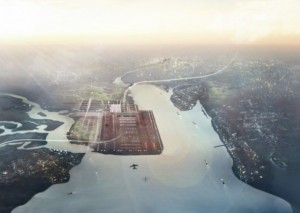Every major city has a master plan for how they want their transportation system to grow to meet increasing demand. These plans often dream big, yet still integrate into current infrastructure. Dreaming big is important, because it sets a goal to reach towards if the funding situation and public sentiment are on board. But sometimes big dreams are so outlandish, albeit interesting, that one cannot imagine such a project ever getting completed (unless it’s in Dubai!)
A recently released plan for a sixth London airport is one of those dreams. Recently written about in the Atlantic Cities, this new airport would be built in the marshlands of the Thames River estuary. The airport would be the hub for air travel, railways, highways, sea shipping, and pipelines. It would be a hub for travel all over the United Kingdom and into Europe. But although just an idea for now, is it worth being brought to the public?
Major infrastructure projects like the Thames airport are unrealistic, even for Dubai! With tight budgets and even tighter environmental restrictions, pushing a major project through for just one mode is a pie-in-the-sky dream, nonetheless many modes – which would require major changes to established systems. This project, like many other independent efforts/dreams, are nice to think about but have nearly no hope of being implemented. The UK struggled for a long-time to determine if they could add on to their high-speed rail system and whether or not it should connect to London Heathrow. Integrating so many modes at a new location is not possible in this day and age.
Such impossible dreams distract the public’s attention from more realistic proposals. Whether big or small, there are projects that exist that take steps towards a more integrated system. One fell swoop to integrate them all is better left to a classroom essay. When it comes to public knowledge, it’s best to properly manage expectations and not propose pipe dreams that get in the way of what’s possible.

